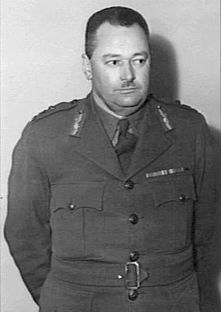Charles Lloyd (Australian general)
Charles Lloyd | |
|---|---|
 Major General Charles Lloyd in 1945 | |
| Nickname(s) | "Gaffer" |
| Born | 2 February 1899 South Fremantle, Western Australia |
| Died | 31 May 1956 (aged 57) Hollywood, Western Australia |
| Buried | Karrakatta Cemetery, Perth |
| Allegiance | Australia |
| Service | Australian Army |
| Rank | Major General |
| Battles / wars | Second World War |
| Awards | Commander of the Order of the British Empire |
Major General Charles Edward Maurice Lloyd, CBE (2 February 1899 – 31 May 1956) was a senior officer in the Australian Army. He saw service in the Second World War, during which he held senior staff and administrative positions. Later he worked as a newspaper executive, as chief of several United Nations agencies, and in private enterprise. Lloyd died in 1956.
Early life
Charles Lloyd was born on 2 February 1899 at South Fremantle, Western Australia, the second and only surviving child of Thomas Edward Lloyd, a postmaster, and his wife Edith, née Lock. His parents separated in 1901 and two years later his father committed suicide. He was subsequently raised by his mother who worked as a telephone attendant at Coolgardie, and then in Fremantle from 1909. Lloyd was educated at Beaconsfield, Fremantle Boys' Central and Perth Modern schools.[1]
Military career
Entering the Australian Army in 1915, Lloyd graduated from the Royal Military College, Duntroon, in 1918 as a regular officer in the artillery, too late to see action during the First World War.[2] Nicknamed "Gaffer" by the other cadets due to his serious demeanor,[1] Gavin Long considered Lloyd among the "ablest" of the group of officers that graduated into the Staff Corps at that time.[3] As a lieutenant he completed his training serving with the British Army in England and India in 1919–20. He married Sybil Drummond in Melbourne on 31 December 1921.[1] Lloyd subsequently held junior staff and regimental postings in Australia during the 1920s, at the same time studying law at the University of Sydney. Later he attended Staff College, Camberley, in the United Kingdom during 1932–33.[2] Next he was appointed Brigade Major of the 4th Divisional Artillery in Melbourne, and was promoted to major in 1937.[1] He was posted to the Directorate of Artillery at Army Headquarters from 1938 to 1939.[2]
Following the outbreak of the Second World War, Lloyd was seconded to the Second Australian Imperial Force (2nd AIF) for overseas service. He held administrative posts in the 6th Division and I Australian Corps in the Middle East during 1940. In December that year, ranked colonel, he was posted to the 9th Division as the senior operational officer, serving as chief of staff to Major General Sir Leslie Morshead; he saw action during the Siege of Tobruk between April and October 1941.[2][1][4] Lloyd then served as chief liaison officer at AIF Headquarters, Middle East. Later he filled a senior staff posting in General Sir Archibald Wavell's ABDA Command during its brief existence, holding the position of Deputy Intendant-General in the Netherlands East Indies with the temporary rank of major general between January and February 1942.[1] Rising from major to major general in less than two-and-a-half years, he became the youngest general officer in the Australian Army.[5]
Lloyd returned to Australia in April 1942 and reverted to the rank of brigadier.[1] He was subsequently appointed Director of Staff Duties at Land Headquarters (LHQ) in July.[2] In September he was briefly posted to I Corps in Papua as Brigadier General Staff under Lieutenant General Sir Sydney Rowell.[1] In February 1943, Lloyd was promoted again to major general and appointed Adjutant General at LHQ by the Commander-in-Chief, General Sir Thomas Blamey, remaining in this position until 1946.[2][1] Leaving the full-time army at the age of 47, he transferred to the reserve in February 1946.[6] Described by Chester Wilmot as "one of the ablest staff officers and most colourful characters of the AIF",[7] and by Wavell as "a staff officer of great quality", during his service Lloyd had been appointed a Commander of the Order of the British Empire (1941) and was mentioned in dispatches three times (1941–42).[1]
Later life
In 1946, Lloyd became a senior executive of the Argus & Australasian newspaper, before unsuccessfully seeking Liberal Party pre-selection for a seat in Federal parliament the same year. In 1948, he was appointed as a member of the government committee that reported on the administration of the British Commonwealth Occupation Force in Japan.[1] His later work included postings as chief of the United Nations Refugee Organisation in Australia and New Zealand (1948–51), and Chief of Mission of the United Nations Korean Reconstruction Agency (1951–53).[6] On return to Australia he took up a position as vice-chairman of Navcot (Aust.) Pty Ltd, a private enterprise which was involved in shipping refugees from Europe as part of the post-war immigration program.[1] Whilst visiting relatives in Western Australia, Lloyd died of jaundice in the Repatriation General Hospital, in Hollywood, Perth, on 31 May 1956. He was survived by his wife, daughter and two sons.[1]
Notes
References
- Clark, Chris (2000). "Lloyd, Charles Edward Maurice (1899–1956)". Australian Dictionary of Biography. Vol. Volume 15. Carlton, Victoria: Melbourne University Press. ISBN 9780522844597.
{{cite book}}:|volume=has extra text (help); Invalid|ref=harv(help) - Dennis, Peter; Grey, Jeffrey; Morris, Ewan; Prior, Robin; Bou, Jean (2008). The Oxford Companion to Australian Military History (Second ed.). Melbourne: Oxford University Press. ISBN 0195517849.
- Long, Gavin (1952). To Benghazi. Australia in the War of 1939–1945. Series 1 – Army. Vol. Volume 1. Canberra: Australian War Memorial. OCLC 18400892.
{{cite book}}:|volume=has extra text (help); Invalid|ref=harv(help) - Maughan, Barton (1966). Tobruk and El Alamein. Australia in the War of 1939–1945. Series 1 – Army. Vol. Volume 3. Canberra: Australian War Memorial. OCLC 954993.
{{cite book}}:|volume=has extra text (help); Invalid|ref=harv(help) - Wilmot, Chester (1993) [1944]. Tobruk 1941. Ringwood, Victoria: Penguin Books. ISBN 9780140175844.
{{cite book}}: Invalid|ref=harv(help)
